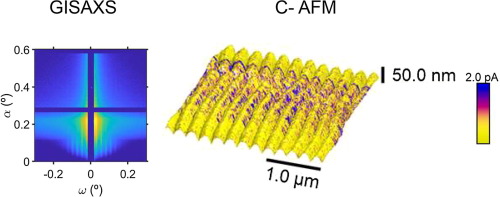当前位置:
X-MOL 学术
›
Appl. Surf. Sci.
›
论文详情
Our official English website, www.x-mol.net, welcomes your
feedback! (Note: you will need to create a separate account there.)
Laser nanostructuring of thin films of PEDOT:PSS on ITO: morphology, molecular structure and electrical properties
Applied Surface Science ( IF 6.3 ) Pub Date : 2020-04-01 , DOI: 10.1016/j.apsusc.2020.145350 Edgar Gutiérrez-Fernández , Ismael A. Gabaldón-Saucedo , Álvaro Rodríguez-Rodríguez , Eduardo Solano , Mari Cruz García-Gutiérrez , Aurora Nogales , Albert Cirera , Tiberio A. Ezquerra , Esther Rebollar
Applied Surface Science ( IF 6.3 ) Pub Date : 2020-04-01 , DOI: 10.1016/j.apsusc.2020.145350 Edgar Gutiérrez-Fernández , Ismael A. Gabaldón-Saucedo , Álvaro Rodríguez-Rodríguez , Eduardo Solano , Mari Cruz García-Gutiérrez , Aurora Nogales , Albert Cirera , Tiberio A. Ezquerra , Esther Rebollar

|
Abstract Nanostructuring is one promising alternative to modify the functionalities of conducting polymers aiming at applications in technologies like organic solar cells, organic field-effect transistors and organic light-emitting diodes. Nowadays, there is an increasing interest in alternative ways of nanostructuring more economic, quicker and reproducible, avoiding the necessity of stringent environmental conditions like clean rooms, high vacuum or complex mask fabrication. Here we prove that Laser Induced Periodic Surface Structures (LIPSS) can be formed in films of Poly(3,4-ethylenedioxythiophene) complexed with Poly(styrenesulfonate) (PEDOT:PSS) prepared by spin-coating on planar Indium Tin Oxide. PEDOT:PSS has been irradiated with the 4th harmonic of a Nd:YAG laser resulting in LIPSS parallel to the laser polarization with a period close to the laser wavelength. LIPSS morphology has been characterized by Atomic Force Microscopy (AFM) and synchrotron Grazing Incidence Small Angle X-ray Scattering while the film structure was studied by Grazing-Incidence Wide-Angle X-ray Scattering and Raman spectroscopy. To analyze the impact of laser treatment on the electrical properties of PEDOT:PSS, conductive AFM was employed showing that LIPSS partially preserve the original electrical conductivity. These results can be of interest for achieving functional polymer nanostructures by a quick and reproducible approach with no need for clean room conditions.
中文翻译:

ITO 上 PEDOT:PSS 薄膜的激光纳米结构:形态、分子结构和电性能
摘要 纳米结构是改变导电聚合物功能的一种有前途的替代方法,旨在应用于有机太阳能电池、有机场效应晶体管和有机发光二极管等技术。如今,人们对更经济、更快和可重复的纳米结构替代方法越来越感兴趣,避免了严格的环境条件,如洁净室、高真空或复杂的掩模制造。在这里,我们证明了激光诱导周期表面结构 (LIPSS) 可以在聚(3,4-亚乙基二氧噻吩)与聚(苯乙烯磺酸)(PEDOT:PSS)复合的薄膜中形成,该薄膜通过在平面氧化铟锡上旋涂制备。PEDOT:PSS 已被 Nd 的 4 次谐波照射:YAG 激光导致 LIPSS 平行于激光偏振,周期接近激光波长。LIPSS 形态已通过原子力显微镜 (AFM) 和同步加速器掠入射小角 X 射线散射表征,而膜结构则通过掠入射广角 X 射线散射和拉曼光谱研究。为了分析激光处理对 PEDOT:PSS 电性能的影响,采用导电 AFM 显示 LIPSS 部分保留了原始导电性。这些结果对于通过无需洁净室条件的快速且可重复的方法实现功能性聚合物纳米结构可能是有意义的。LIPSS 形态已通过原子力显微镜 (AFM) 和同步加速器掠入射小角 X 射线散射表征,而膜结构则通过掠入射广角 X 射线散射和拉曼光谱研究。为了分析激光处理对 PEDOT:PSS 电性能的影响,采用导电 AFM 显示 LIPSS 部分保留了原始导电性。这些结果对于通过无需洁净室条件的快速且可重复的方法实现功能性聚合物纳米结构很有意义。LIPSS 形态已通过原子力显微镜 (AFM) 和同步加速器掠入射小角 X 射线散射表征,而膜结构则通过掠入射广角 X 射线散射和拉曼光谱研究。为了分析激光处理对 PEDOT:PSS 电性能的影响,采用导电 AFM 显示 LIPSS 部分保留了原始导电性。这些结果对于通过无需洁净室条件的快速且可重复的方法实现功能性聚合物纳米结构可能是有意义的。使用导电 AFM 表明 LIPSS 部分保留了原始的导电性。这些结果对于通过无需洁净室条件的快速且可重复的方法实现功能性聚合物纳米结构可能是有意义的。使用导电 AFM 表明 LIPSS 部分保留了原始的导电性。这些结果对于通过无需洁净室条件的快速且可重复的方法实现功能性聚合物纳米结构可能是有意义的。
更新日期:2020-04-01
中文翻译:

ITO 上 PEDOT:PSS 薄膜的激光纳米结构:形态、分子结构和电性能
摘要 纳米结构是改变导电聚合物功能的一种有前途的替代方法,旨在应用于有机太阳能电池、有机场效应晶体管和有机发光二极管等技术。如今,人们对更经济、更快和可重复的纳米结构替代方法越来越感兴趣,避免了严格的环境条件,如洁净室、高真空或复杂的掩模制造。在这里,我们证明了激光诱导周期表面结构 (LIPSS) 可以在聚(3,4-亚乙基二氧噻吩)与聚(苯乙烯磺酸)(PEDOT:PSS)复合的薄膜中形成,该薄膜通过在平面氧化铟锡上旋涂制备。PEDOT:PSS 已被 Nd 的 4 次谐波照射:YAG 激光导致 LIPSS 平行于激光偏振,周期接近激光波长。LIPSS 形态已通过原子力显微镜 (AFM) 和同步加速器掠入射小角 X 射线散射表征,而膜结构则通过掠入射广角 X 射线散射和拉曼光谱研究。为了分析激光处理对 PEDOT:PSS 电性能的影响,采用导电 AFM 显示 LIPSS 部分保留了原始导电性。这些结果对于通过无需洁净室条件的快速且可重复的方法实现功能性聚合物纳米结构可能是有意义的。LIPSS 形态已通过原子力显微镜 (AFM) 和同步加速器掠入射小角 X 射线散射表征,而膜结构则通过掠入射广角 X 射线散射和拉曼光谱研究。为了分析激光处理对 PEDOT:PSS 电性能的影响,采用导电 AFM 显示 LIPSS 部分保留了原始导电性。这些结果对于通过无需洁净室条件的快速且可重复的方法实现功能性聚合物纳米结构很有意义。LIPSS 形态已通过原子力显微镜 (AFM) 和同步加速器掠入射小角 X 射线散射表征,而膜结构则通过掠入射广角 X 射线散射和拉曼光谱研究。为了分析激光处理对 PEDOT:PSS 电性能的影响,采用导电 AFM 显示 LIPSS 部分保留了原始导电性。这些结果对于通过无需洁净室条件的快速且可重复的方法实现功能性聚合物纳米结构可能是有意义的。使用导电 AFM 表明 LIPSS 部分保留了原始的导电性。这些结果对于通过无需洁净室条件的快速且可重复的方法实现功能性聚合物纳米结构可能是有意义的。使用导电 AFM 表明 LIPSS 部分保留了原始的导电性。这些结果对于通过无需洁净室条件的快速且可重复的方法实现功能性聚合物纳米结构可能是有意义的。









































 京公网安备 11010802027423号
京公网安备 11010802027423号